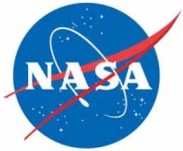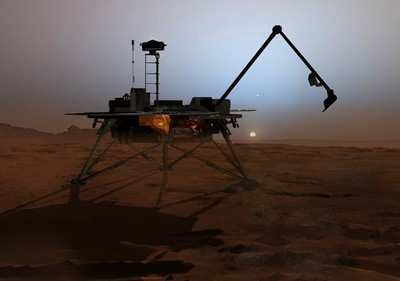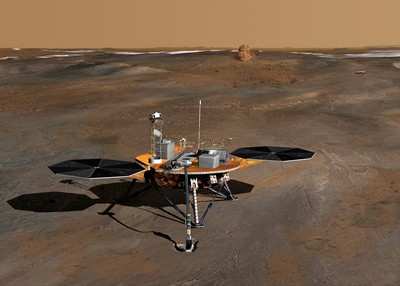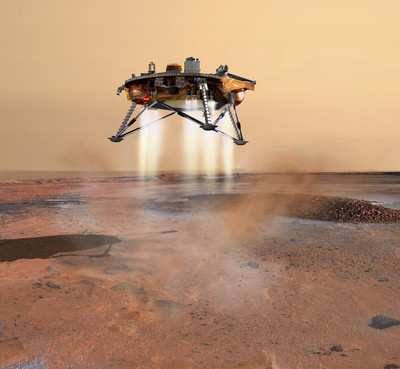Team Delights In Spot-On Landing
 296 days after its launch aboard a
Delta II launch vehicle, the Phoenix Mars Lander successfully
landed on the Martian surface at 1653 PDT with a soft touchdown as
planned.
296 days after its launch aboard a
Delta II launch vehicle, the Phoenix Mars Lander successfully
landed on the Martian surface at 1653 PDT with a soft touchdown as
planned.
Assisted by communications relays from the Mars Reconnaissance
Orbiter and Mars Odyssey, the team at NASA's Jet Propulsion
Laboratory, Pasadena, CA said that the landing sequence went as
smooth as could be imagined. The mood was tense as the team awaited
word on each stage of the system through the 15 minute delay
between transmission and receipt of the signal on earth.
After months during the cruise phase filled with testing of
procedures, equipment and software in preparation for arrival at
Mars the spacecraft completed the 121 million mile journey that
started on August 4 of last year. During the course of the cruise
phase the Phoenix had six opportunities to fire thrusters to adjust
trajectory to assure the "arrow hit the target."
Mission controllers decided Saturday night and Sunday morning to
forgo the last two opportunities for adjusting the spacecraft's
trajectory.
"We were so well on course that those adjustments were not
necessary," said Phoenix Project Manager Barry Goldstein.
As ANN reported two weeks
ago, tensions were high as the Phoenix neared the
planet and preparations for the landing began.
The most challenging part of the entire mission, getting from
the top of the atmosphere to a safe landing on three legs, was the
most anticipated portion of the mission by the team.
Internationally, only five of the 11 attempts to land a spacecraft
on Mars have succeeded.
The intense entry, descent and landing period starting three
hours before the spacecraft enters Mars' atmosphere until it
reached the ground safely went according to plan. The craft hit the
top of the atmosphere at a speed of 5.7 kilometers per second
(12,750 miles per hour). Over the next six and a half minutes, it
used heat-generating atmospheric friction, then a parachute, then
firings of descent thrusters that brought velocity down to about
2.4 meters per second (5.4 miles per hour) just before
touchdown.

"This team performed perfectly!" said Peter Smith Phoenix
Principal Investigator with the University of Arizona team to NASA
TV shortly after the landing was announced.
Unlike the last three successful landings on Mars that used
airbags to cushion the impact to the surface, Phoenix used descent
thrusters in the final seconds down to the surface and successfully
set down onto three legs. The landing system is similar to NASA's
1976 Viking landers.
Within an hour and a half after landing, NASA awaited
confirmation of the deployment of the solar array that will provide
power to the Phoenix. Once that confirmation is made by Mars
Odyssy in an overflight the lander will be checked for system
health and images will start being transmitted from it.
In subsequent days, when the lander has been evaluated as safe
to proceed with its science mission, the center of operations will
switch to the University of Arizona, Tucson. Over the next week or
so, a series of checkouts will characterize the performance and
readiness of the lander's subsystems and science instruments.
Planned activities for this phase of the mission include using the
Robotic Arm Camera to see the footpads and delivering a sample of
surface soil.
The Phoenix Mars Mission is the first of NASA's competitively
proposed and selected Mars Scout missions, supplementing the
agency's core Mars Exploration Program, whose theme is "follow the
water."
"The Phoenix mission not only studies the northern permafrost
region, but takes the next step in Mars exploration by determining
whether this region, which may encompass as much as 25 percent of
the Martian surface, is habitable," said Smith.

The University of Arizona was selected to lead the mission in
August 2003 and is the first public university to lead a Mars
exploration mission.
The Phoenix mission is led by Smith, with project management at
JPL. The development partnership is with Lockheed Martin, Denver.
International contributions are from the Canadian Space Agency; the
University of Neuchatel, Switzerland; the universities of
Copenhagen and Aarhus, Denmark; the Max Planck Institute, Germany;
and the Finnish Meteorological Institute.
Original Report
1955 EDT: It's down! Moments ago, NASA received
confirmation from the Mars Phoenix lander it had landed softly on
the surface of the Red Planet.

"Phoenix has landed! Phoenix has landed!" Mission Control
exclaimed upon termination of the EDL signal relayed to Earth
through the Mars Odyssey, about 90 seconds after the orbiter
signaled touchdown on the planet's surface. The signal termination
marked the beginning of the lander's autonomous operations.
Radio signals are received by NASA on Earth about 15
minutes after they are transmitted from Mars.
Confirmation of the next milestone will occur in about one
hour, when Phoenix will deploy its twin circular solar panels, and
the lander transmits its first pictures from the Martian
surface.
 ANN's Daily Aero-Term (05.07.25): Terminal Radar Service Area
ANN's Daily Aero-Term (05.07.25): Terminal Radar Service Area ANN's Daily Aero-Linx (05.07.25)
ANN's Daily Aero-Linx (05.07.25) Classic Aero-TV: Anousheh Ansari -- The Woman Behind The Prize
Classic Aero-TV: Anousheh Ansari -- The Woman Behind The Prize NTSB Prelim: Bell 206B
NTSB Prelim: Bell 206B Airborne-NextGen 05.06.25: AF Uncrewed Fighters, Drones v Planes, Joby Crew Test
Airborne-NextGen 05.06.25: AF Uncrewed Fighters, Drones v Planes, Joby Crew Test






